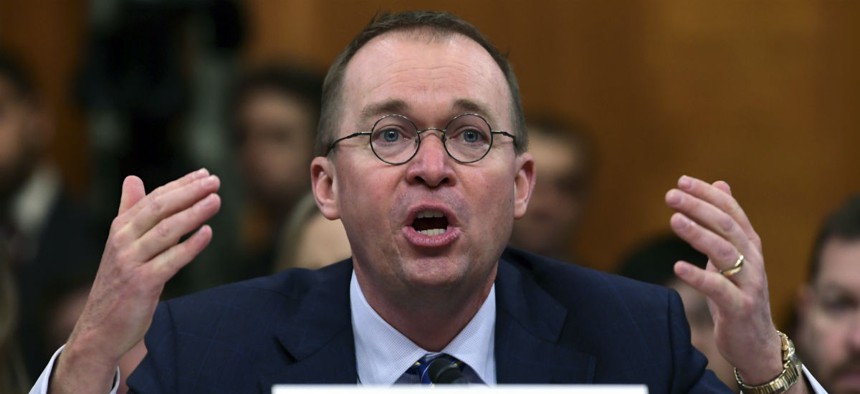
OMB Director Mick Mulvaney testifies on Capitol Hill Tuesday about the Trump administration's budget request. Susan Walsh/AP
Trump's Proposed Program Cuts Hint at Where Agency Jobs Could Vanish
Budget's reductions and eliminations justified under rubric of “not working.”
White House Budget Director Mick Mulvaney on Monday was asked by reporters to define a “loser” under the Trump administration’s just-released fiscal 2019 budget request.
“The losers are things like Trade Adjustment Assistance,” he said of the Labor Department program to retrain workers that he slated for a $98 million cut. “We reform TAA. Why? Because it doesn’t seem to work. In fact, the data that we have seems to suggest that folks who go through that program actually end up in lower-paying jobs than folks who don’t go through the program.”
The Trump budget included a special section titled “Major Savings and Reform” that called for outright elimination of not only more than a dozen small agencies, but dozens of programs, along with major cuts in others at nearly every department. Each of those programs is staffed by federal employees whose job may now be in jeopardy—depending on Congress’s reaction and agency reorganizations.
Some planned cuts and reforms involve familiar programs. The Environmental Protection Agency’s Energy Star and Voluntary Climate Programs, for example, would be zeroed out because “they are not essential to EPA’s core mission and can be implemented by the private sector.”
An example of a reorganization to save money would affect the Bureau of Alcohol, Tobacco, Firearms and Explosives. The Justice Department budget called for transferring its responsibilities related to alcohol and tobacco enforcement to the Treasury Department’s Alcohol and Tobacco Tax and Trade Bureau. “The transfer will focus ATF resources on its violent crime role,” the budget stated. “As part of that focus, ATF will pursue a workforce refresh effort, leveraging attrition from its retirement-eligible workforce to invigorate a cadre of agents to work on ATF’s violent crime initiatives.”
Similarly, the federal prison system “will save over $122 million by reducing positions to historical inmate-to-staff ratios, closing two regional offices, and closing two stand-alone minimum security prison camps,” the Justice proposal said.
And at the U.S. Institute for Peace, which the Trump budget last year targeted for elimination, “the budget assumes that USIP, like any other foreign assistance implementer, would have to compete for more of its funding through interagency agreements with other federal agencies, rather than rely on its direct appropriation as its primary funding source.” The document proposed a cut of $18 million.
At the Environmental Protection Agency, the budget called for cuts of half a billion dollars for categorical grants to states and tribes, and it trimmed as much as $327 million from the Superfund cleanup program, and cut $229 million from research and development programs.
The budget’s “Major Savings and Reforms” section proposed zero funding for some offices and programs at nearly every major department. For example:
- At the Agriculture Department, Trump would defund the McGovern-Dole international food for education program and the Rural Business and Cooperative Service.
- At the Commerce Department, no money would be allocated to National Oceanic and Atmospheric Administration grants and education.
- At the Education Department, international education would be zeroed out, along with the community-based tutoring projects called 21st Century Community Learning Centers.
- At the Health and Human Services Department, the budget would zero out the community services block grant, the health workforce programs, the low-income home energy assistance program and the Agency for Healthcare Research and Quality.
- At the Housing and Urban Development Department, the budget proposed saving a whopping $3 billion in one year by abolishing the community development block grant program.
- At the Interior Department, the budget would cancel out the Centennial Challenge Fund, the Heritage Partnership program and the National Wildlife Refuge Fund.
- The Justice Department would kill funding for the state criminal alien assistance Program.
- The Labor Department would defund migrant and seasonal farmworker training, training grants at the Occupational Safety and Health Administration, the senior community service employment program and the Indian and Native American program.
- At the State Department and the U.S. Agency for International Development, the budget would remove the duties of some officials in proposing killing the $160 million used for the Global Climate Change Initiative. It also proposed no dollars for the nonprofit Asia Foundation and the nonprofit East-West Center.
- The Treasury Department would kill the global agriculture and food security program and the International Fund for Agricultural Development.
- At NASA, which is slated for an overall increase, the Trump budget called for abolishing its Office of Education.
In his Monday talk with reporters, Mulvaney acknowledged the likely resistance in Congress. “We sent up $54 billion worth of savings last year to the Hill, and they took about $5 billion worth of it,” he said. “They didn’t make any of the large structural changes that we proposed.”
But the Trump team takes solace, he suggested, in delivering a budget that focuses on its own priorities. To agencies, he said, that might mean, “If you’re going to spend it all— you spend it like this. …But you don’t have to spend it all. These are spending caps. They are not spending floors.”







